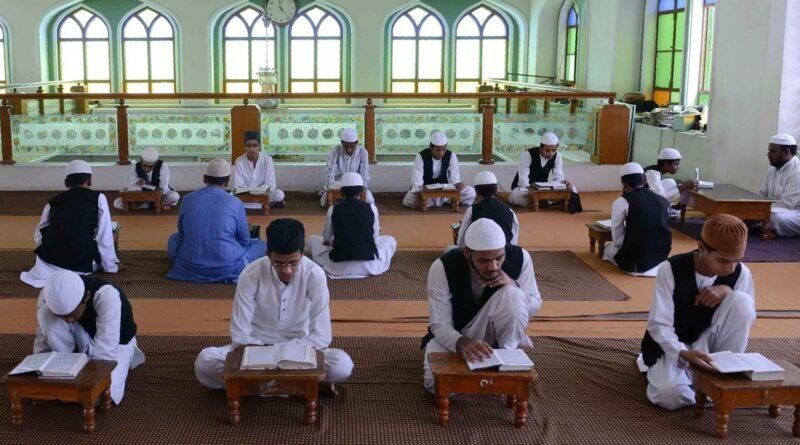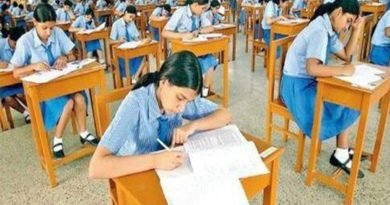The only Indian high schools that teach Aristotle and Plato
The philosophical-religious education of madrasas that included Aristotelian logic, rhetoric and fostered a spirit of enquiry has been rendered obsolete.
July 10, dmanewsdesk: “For 12 marks, write an essay that explains in detail the distinction between conceptual thought and certified knowledge and their forms?”
This is a question asked of 15-year-olds appearing for the Class 10 board examinations in madrasa schools in Uttar Pradesh.
To answer this question, students must know philosopher Avicenna’s key theories. They must also have some familiarity with the ideas of Greek philosopher Aristotle, from whom this distinction between imagination (tassavur) and assertion or certified knowledge (tasdiq) derives from.
That is a high bar for anyone, not just a teenager.
These foundations of ancient Judaeo-Christian-Islamic thought, including a paper on logic and philosophy, are among the subjects taught to students of the Uttar Pradesh Madarsa Education Board – unusual for Indian school-level curriculums that otherwise do not offer philosophy in any form.
However, madrasa students are exposed early on to a gamut of Aristotelian and neo-Platonic thought, with entire subjects dealing with rational sciences (ma’aqullat) that cover ancient Greek and Islamic philosophical traditions.
Modern-day critics of madrasas paint them as obscurantist, irrelevant and based on outdated syllabi emphasising rote learning that fails to instill a spirit of enquiry. Today, madrasas are seen as dens of fundamentalism and illiberal thought, obsessed with religion. These critics say that such an education fails to equip students with the tools to enter the mainstream.
Advocates of madrasa learning acknowledge the validity of these criticisms and have attempted to rectify this by including science and languages such as Hindi and Bengali in the syllabus. But they have resisted tinkering with the core of the curriculum, arguing that religious education is based on revealed knowledge in religious texts that is fixed and unchanging and cannot be periodically revised.
A significant component of madrasa education indeed focusses on Islamic religious instruction and madrasa education has limitations, but it certainly is not sub-standard or based solely on rote learning.
Madrasa curriculum also taught several diverse systems of knowledge that other education boards no longer teach. Today, madrasas are one of the last remaining outposts of classical learning and knowledge – remnants of an education imparted to 18th- and 19th-century gentlemen everywhere, including in the Western academy.
Criticism of madrasa education
In large parts of the Islamic world, a “madrasa” is an institution that imparts education – secular, or religious. In the modern subcontinent, however, “madrasa” has evolved to refer solely to Islamic seminaries.
But the first educational institute the British set up in India in 1780 was called the Calcutta Madrasah. Until as recently as this century, Zorastrian seminaries such as The Dadar Athornan Madressa used the term “madrasa”.
The debate on madrasa reform and modernisation has a long and convoluted history going back more than 200 years ago to early British rule in Bengal. The colonial administration sought to foster and make more relevant “Oriental learning” by creating textbooks, tinkering with curriculum and standardising pedagogy.
More recently, the ruling Bharatiya Janata Party in some states has also targeted madrasas. In March, the Allahabad High Court struck down the UP Board of Madarsa Education Act, 2004.
The judgement said that education in madrasas was not equivalent to the learning that students would receive in regular, state-recognised institutions. It held that education imparted by madrasas is neither of “quality” nor “universal in nature”.
In Assam, the BJP-ruled government in December ordered the conversion of “government and provincialised madrasas” into general schools.
Religion, knowledge, administration
Because of the historic flow of ideas from the ancient Greek world to the Islamic world, and the fact that much of Islamic philosophy engaged with Aristotle and neo-Platonic thought, a great deal of today’s syllabus, especially first principles, is based entirely on ancient Greek philosophical thought.
Most traditional madrasas in India base their syllabus on the traditional Dars-e Nizami curriculum formulated by Nizamuddin Sihalvi, a 17th-century Islamic teacher and scholar based out of Firangi Mahal, Lucknow.
Originally, the madrasa curriculum sought to not only create religious specialists, but also to train administrators and inculcate a love for knowledge among students.
Like classical education everywhere in the world, it emphasised then, and continues to do so today, training in religion complemented with rigorous education in grammar, logic, philosophy and rhetoric – once seen as essential tools to succeed in the world.
This system did not make a clear distinction between secondary, higher secondary and graduate education that modern educational systems do. Depending on how many years and how far one got in the curriculum, one would end up either being a maulvi, alim (knowledgeable), kamil (perfect) or fazil (excellent).
Religious Islamic education dominates the syllabus but students are exposed to a range of other ideas. Students can not complete a madrasa education without reading texts as diverse as Maqamat-e Hariri, an Arabic tale about a roguish rascal’s adventures, selections from the Divan Mutannabi, written by a 10th-century, ego-maniacal Abbasid poet and pseudo-prophet Mutannabi, and the Muʻallaqat (Hanging Poems), pre-Islamic pagan poetry that were once hung in the Ka’aba. None of these are religious or Islamic texts by any stretch of the imagination.
Subjects like prosody, which is the art and science of rhyme, and rhetoric are rarely taught under modern Indian educational boards at the senior secondary level. Many English-medium students would not know the iambic pentameter, but madrasas continue to teach prosody as a distinct subject – ilm-ul-’arooz – at the senior secondary level.
Typical Class 10 high-school exam questions that 15-year-olds are expected to answer involve explaining the distinction between felicity of speech (fasahat) and eloquence of language (balaghat).
Knowledge of the nuances of rhetorical devices is emphasised at all levels. For instance, another question of the UP Madrasa Board – for eight marks only – asked to define, with examples, a) simile (tashbih), b) allusion (talmih), c) metaphor (isti’arah) and d) aetiologic effect (husn-e ta’lil).
Rational sciences, logic and philosophy
Such extensive reading in rhetoric and literature – secular and religious – has parallels with other traditional education systems. But a unique feature of the madrasa system is the emphasis on the rational sciences, or ma’aqullat.
It was originally a broad subject that covered all forms of learning that could be grasped through reason (‘aql), including sciences such as astronomy. Over the centuries, it morphed in the Dars-e Nizami system to focus on logic (mantiq) and philosophy (falsafa).
These were and still are taught in early grades in madrasas to aid the study of religious subjects and to also facilitate the development of skills of argument, debate and critical inquiry.
Students are also exposed to the ideas of philosophers Avicenna (d 1037), and Fakhruddin Razi (d 1209), and learn the concepts of analogical reasoning (qiyas) and inductive logic (istiqra).
Foundational concepts, such the distinctions between space (makan), locus (hayyiz), body/substance (jism) and form (shaql), are taught today in conceptual form to tenth graders using the language of Greek thought, not found anywhere else in the Indian education system.
Modernising madrasas
An unfortunate consequence of repeated attempts to modernise madrasas has been the truncation of this logic and philosophy syllabus. From a mandatory subject taught from the foundational years, it has become an optional paper, replaced with “modern” subjects such as computer typing.
What reformers fail to realise is that it serves as a sheet-anchor and provides tools to critically engage with other subjects – secular and religious. Truncating the component that teaches critical inquiry weakens the entire edifice.
This style of learning was priceless once, a marker erudition and refinement. Today, it is a remnant of a classical worldview that prized intellectual curiosity, and the spirit of enquiry and knowledge.
One can debate the relevance of such knowledge in today’s world. But the same arguments can be made of the use and application of differential calculus, or organic chemistry in everyday life.
Whether it has practical application in day-to-day life is irrelevant, but it does provide learners with a set of tools and skills with which to critically examine and comprehend the world.
That an education steeped in secular philosophy, logic and a close reading of the greats is no longer valued today reflects the low premium placed by modern society on classical education, not on the syllabus itself.
Source: Scroll.in




